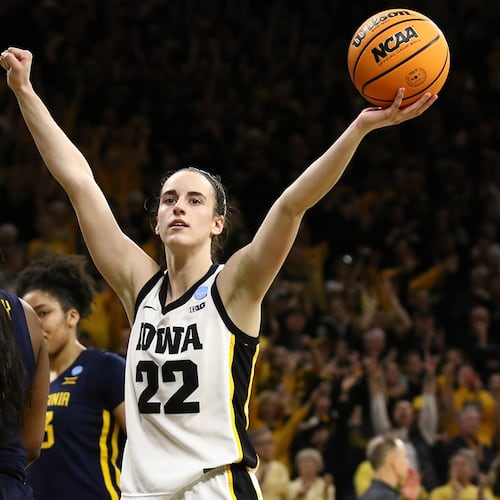The Braves got ripped on social media, that bastion of circumspection, for not spending more over the winter. They just re-upped their two best young players for what could be a total of $169 million and, in the case of the second young player, got ripped for not spending enough. We can only conclude that those who live to rage won’t be satisfied until the Braves track down Melvin (nee B.J.) Upton and Dan Uggla and offer each double what Mike Trout just got.
But nah. The only thing anybody really likes on social media is pictures of cats. Maybe Alex Anthopoulos should invest in cuddly furballs.
Lost in the latest furor over the Braves’ spending – or, if you prefer, the willful and wanton lack thereof – is that AA the GM has a plan, which general managers tend to do, and is executing that plan. This correspondent has spent four-plus decades being wrong about most everything, but even a blind squirrel … well, you know. On March 27, these fallible fingers typed the following: “There’s no way the Braves will allow Ronald Acuna to play much longer without locking him up long-term, and the same could hold for Ozzie Albies and whichever young pitchers break upward.”
Lo and behold, Acuna is now under contract through 2026, with club options for two years beyond that, and Albies is signed through 2025, again with club options for the next two seasons. This is exactly the sort of thing a 21st-century GM sitting atop a bountiful farm system should be doing – it’s far more economic to keep your own than buy somebody else’s – though we note that John Hart, of whom you’ve heard, was doing it in the 1990s.
Hart, recently jettisoned as the Braves’ president of baseball operations, was then Cleveland’s GM. You’ll recall those Indians from the 1995 World Series – that was the one the Braves didn’t lose – and their plethora of great young hitters/fielders: Belle, Baerga, Manny, Thome, Vizquel. Hart pretty much pioneered the proactive contract, signing those guys long-term to keep from having to fight them in arbitration and then risk losing them at the first sight of free agency. Maybe it was just coincidence, but soon after John Schuerholz commissioned Hart as a Braves consultant, then-GM Frank Wren did the same in early 2014 with Freddie Freeman, Craig Kimbrel, Julio Teheran and Andrelton Simmons.
The nice thing about having good young players is that they’re good, duh, and they’re cheap. But those young players get older and become less cheap. Arbitration is always messy. (Ask Jeff Francouer about that.) If a guy is set on testing his worth in free agency, there’s almost no way to placate him. (Ask Jason Heyward about that.) The latter wasn’t among the Wren re-ups because he wanted to see what was out there. The answer: $184 million from the Cubs.
Acuna and Albies are the leaders of the Braves’ youth movement, but it’s not a two-man class. What if Dansby Swanson’s early success holds? What if Mike Soroka stays healthy? What if Sean Newcomb makes the transition from decent starter to plus-performer? What of Mike Foltynewicz, an All-Star who can become a free agent after the 2021 season? Young players don’t stay young – or cheap – forever.
To suggest that the fuss over the apparent paucity of the Braves’ Albies outlay – a max of $45 million over nine years – was solely a function of outrage-fueled social media would be incorrect. The sabermetric community was unanimous in its incredulity, which makes sense. The aim of sabermetrics is to levy a value on everything; hence the advent of WAR and FIP and suchlike. There’s no denying that Albies signed for far under his projected value, but he’s a multimillionaire at age 22. Pre-extension, he was set to earn $575,000 this season.
Go back to those words – “projected value.” That’s not to be confused with performance, which is where real value lies. (Sorry if I’m sounding pedantic here.) There’s no guarantee that Albies will play to his expected level. (Again we reference Upton/Uggla.) More to the point, he can’t go to the bank and say, “See these numbers? Dan Szymborski’s ZiPS show I should be worth $100 million soon – could you advance me that now?”
The team offers a guaranteed future. (Even in today’s world, $35 million should set a guy up nicely.) The player trades possible earnings for cash money. The MLB Players Association hates it when that happens, but we can assume that Albies had MLBPA-approved representation when he signed. As much as we’d like to think that every club treats all its players as, ahem, family, the cold reality is that they’re employees. The Braves aren’t a non-profit. Locking down Acuna and Albies for dimes on the dollars they might – emphasis on “might” – have made is, as cruel as it might sound, good business.
The inevitable sentiment expressed in the backlash over Albies’ allegedly raw deal was that, having saved so much on their two young stars, the Braves must now go out and buy a free agent. This misses the point by as much as Uggla once missed breaking balls. The Braves are investing – and re-investing – in youth because they don’t want or feel a need to augment this team with pricey imports. They like what they have, and they want to keep it as long as possible.
No, that’s not as sexy as signing Bryce Harper for $320 million, but that’s the plan. And if you don’t like it ... well, would you care to see some cat snaps?
About the Author
The Latest
Featured


